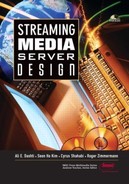4.3. Evaluation
We evaluated techniques described in this chapter using a trace driven simulation study. This trace was generated synthetically using a Poisson arrival pattern. In all simulations presented in this section, we assumed a single media type with 4 Mb/s bandwidth requirement and a block size of 0.5 Mbytes (Tp = 1 second). Blocks were distributed across twenty Quantum Atlas XP32150 disks using random. Our repository consisted of 50 different edited clips each consisting of 120 logical blocks. We assumed a uniform distribution of access to the clips.
All results demonstrate that the hiccup probability decreases as a function of N (number of buffers), see Figure 4.5.a. For example, we can reduce the hiccup probability to less than one in a million by increasing the number of buffers to seven. This probability implies that a hiccup only happens approximately once in 12 days when a client continuously displays clips. This would be satisfactory for almost all applications.
Figure 4.5. Startup latency distribution of PB techniques.
(a) Hiccup probability.

(b) Avg.startup latency (N=7).

Table 4.2 shows that Skip provides a lower hiccup probability than Wait because Skip minimizes the server's load by not servicing requests that have already violated their deadlines. This difference becomes more profound when the number of buffers decreases because this increases the percentage of requests that miss their deadline. It is important to note that the use of Skip is application dependent. Those applications that can tolerate skipping content should use Skip in order to minimize the probability of hiccup. For the rest of this evaluation, we assume the Wait scheme.
| Schemes | Number of buffers (N) | ||||||
|---|---|---|---|---|---|---|---|
| 2 | 3 | 4 | 5 | 6 | 7 | ||
| Avg. retrieval time (msec) | Skip | 296.4 | 338.7 | 348.8 | 351.9 | 352.6 | 352.6 |
| Wait | 336.6 | 347.9 | 351.9 | 352.4 | 352.6 | 352.6 | |
| Hiccup probability | Skip | 0.011388 | 0.001195 | 0.000238 | 0.000043 | 0.000002 | < 10–b |
| Wait | 0.042648 | 0.005485 | 0.001064 0 | 000212 | 0.000005 | < 10–b | |
Table 4.3 shows a comparison of alternative PB techniques. The results demonstrate that the probability of hiccups is almost identical with all techniques. Figure 4.5.b and 4.6.a show the average startup latency and the worst latency as a function of N. Figure 4.6.b shows the distribution of startup latency when N=7. The y-axis of this figure is the probability of a display incurring a certain startup latency. For example, the peak point of PBV-AD illustrates that 44% of displays experience startup latency between 100 msec and 150 msec. The aggressive display (AD) approach provides a better startup latency distribution, i.e., a smaller average and variance, than the conservative display (CD) approach. Overall, both PBV-AD and PBF-AD are superior to the other alternatives when it comes to startup latency. Hence, this can satisfy almost all the latency-sensitive applications, even in the worst case scenario (336 msec), with a hiccup probability that is less than one in a million (< 10–6).
Figure 4.6. Startup latency distribution of PB techniques.
(a) Worst startup latency.

(b) Startup latency distribution (N=7).

| Schemes | Number of buffers (N) | ||||||
|---|---|---|---|---|---|---|---|
| 2 | 3 | 4 | 5 | 6 | 7 | ||
| Avg. retrieval time (msec) | PBF-CD | 335.7 | 348.1 | 352.5 | 354.3 | 355.4 | 357.1 |
| PBF-AD | 335.7 | 348.1 | 352.7 | 354.3 | 355.6 | 357.0 | |
| PBV-CD | 335.7 | 347.8 | 350.5 | 352.7 | 353.8 | 355.9 | |
| PBV-AD | 335.7 | 347.7 | 352.5 | 354.0 | 355.6 | 357.3 | |
| Hiccup probability | PBF-CD | 0.041364 | 0.005574 | 0.001200 | 0.000293 | 0.000027 | < 10–6 |
| PBF-AD | 0.041364 | 0.005598 | 0.001213 | 0.000281 | 0.000023 | < 10–6 | |
| PBV-CD | 0.041364 | 0.005276 | 0.001115 | 0.000196 | 0.000021 | < 10–6 | |
| PBV-AD | 0.041364 | 0.005681 | 0.001212 | 0.000261 | 0.000021 | < 10–6 | |
| Avg. startup latency (msec) | PBF-CD | 318.2 | 186.6 | 148.7 | 195.9 | 206.2 | 224.2 |
| PBF-AD | 318.2 | 148.5 | 140.5 | 139.4 | 138.5 | 139.8 | |
| PBV-CD | 318.2 | 369.0 | 375.3 | 380.1 | 389.8 | 420.6 | |
| PBV-AD | 318.3 | 147.7 | 139.5 | 138.1 | 136.9 | 137.7 | |
| Standard deviation of startup latency | PBF-CD | 281.7 | 144.2 | 93.5 | 59.5 | 48.3 | 52.9 |
| PBF-AD | 281.7 | 106.0 | 65.4 | 48.0 | 40.7 | 40.5 | |
| PBV-CD | 281.7 | 325.3 | 334.6 | 326.2 | 327.5 | 351.2 | |
| PBV-AD | 281.7 | 103.8 | 64.4 | 45.1 | 38.1 | 37.4 | |
| Worst startup latency (msec) | PBF-CD | 2861 | 2708 | 2430 | 1883 | 881 | 512 |
| PBF-AD | 2861 | 2534 | 2524 | 1999 | 980 | 406 | |
| PBV-CD | 2861 | 3515 | 4409 | 4373 | 4740 | 5087 | |
| PBV-AD | 2861 | 2552 | 2437 | 1828 | 891 | 336 | |
Similar trends were observed with our other simulation studies that utilized different parameters such as utilization, block size, number of disks. Generally, a lower hiccup probability is observed when the system utilization is lower. The number of disks does not impact the performance unless it is too small (less than 6). With a smaller block size, the portion of disk seek time becomes greater and it results in a higher disk utilization and a lower hiccup probability.
